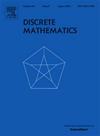Hamming图上的自举渗透
IF 0.7
3区 数学
Q2 MATHEMATICS
引用次数: 0
摘要
图上的r边自举渗透是一个边的激活过程。这个过程从一些初始激活的边开始,然后,在每一轮中,任何一个端点与至少r个活动边相关的非活动边被激活。导致所有边被激活的一组初始激活的边被称为一个渗透集。用我(G,r)表示图G上的r边自举渗流过程中渗流集的最小大小。r边自举渗流的重要性在于me(G,r)提供了m(G,r)上的界,即G上r邻自举渗流过程中渗流集的最小大小。本文明确地确定了me(Knd,r),其中Knd是n个顶点上完整图的d个拷贝的笛卡尔积,称为Hamming图。利用这个,我们证明了m(Knd,r)=(1+o(1))dr - 1r!当n,r是固定的并且d趋于无穷这扩展了超立方体上的一个已知结果。本文章由计算机程序翻译,如有差异,请以英文原文为准。
Bootstrap percolation on the Hamming graphs
The r-edge bootstrap percolation on a graph is an activation process of the edges. The process starts with some initially activated edges and then, in each round, any inactive edge whose one of endpoints is incident to at least r active edges becomes activated. A set of initially activated edges leading to the activation of all edges is said to be a percolating set. Denote the minimum size of a percolating set in the r-edge bootstrap percolation process on a graph G by . The importance of the r-edge bootstrap percolation relies on the fact that provides bounds on , that is, the minimum size of a percolating set in the r-neighbor bootstrap percolation process on G. In this paper, we explicitly determine , where is the Cartesian product of d copies of the complete graph on n vertices which is referred as Hamming graph. Using this, we show that when are fixed and d goes to infinity which extends a known result on hypercubes.
求助全文
通过发布文献求助,成功后即可免费获取论文全文。
去求助
来源期刊

Discrete Mathematics
数学-数学
CiteScore
1.50
自引率
12.50%
发文量
424
审稿时长
6 months
期刊介绍:
Discrete Mathematics provides a common forum for significant research in many areas of discrete mathematics and combinatorics. Among the fields covered by Discrete Mathematics are graph and hypergraph theory, enumeration, coding theory, block designs, the combinatorics of partially ordered sets, extremal set theory, matroid theory, algebraic combinatorics, discrete geometry, matrices, and discrete probability theory.
Items in the journal include research articles (Contributions or Notes, depending on length) and survey/expository articles (Perspectives). Efforts are made to process the submission of Notes (short articles) quickly. The Perspectives section features expository articles accessible to a broad audience that cast new light or present unifying points of view on well-known or insufficiently-known topics.
 求助内容:
求助内容: 应助结果提醒方式:
应助结果提醒方式:


